As we speak, $376 billion is locked up in five of Wall Street’s most overrated, overloved funds. And the sad reality is that there’s a high chance a few thousand bucks of that are courtesy of … well, you.
The good news? I can show you seven far better options.
While Wall Street still rolls out hundreds of new exchange-traded funds every year, one of the greatest advantages for any ETF is age. Funds that got an early start have marketing advantages, media advantages and tend to come from companies that can compete on price, meaning bargain-basement fees that undercut the competition and keep newer fund providers from even bothering to jump into the space.
But sometimes, the most-hyped pundit favorites aren’t the best.
Just take a look at the financial space, where the Financial Select Sector SPDR ETF (XLF) is the king of the roost at over $24 billion in assets – that’s more than quadruple the next largest fund. But has the XLF rewarded that outsize investor faith over the past decade-plus?
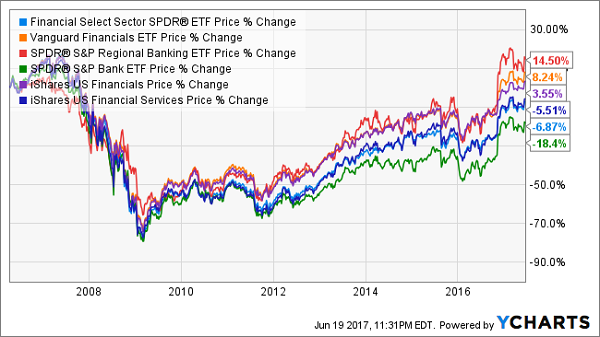
You tell me.
Right now, it’s highly likely that you own at least one if not more of the following five ETFs, as they’re the top asset-holders in five of the most-sought-after investment categories on the market, from high dividend yield to even gold! I urge you to read on as I set the record straight in these five well-worn funds, and show you seven upgrades that will give you much more bang for your buck.
iShares U.S. Preferred Stock ETF (PFF)
Assets: $18.1 billion
Category Asset Rank (Preferred Stock): 1
Overall Asset Rank: 36
I love preferred stocks. These stock-bond “hybrids” offer extraordinarily safe high yields that enjoy an extra level of protection than common stocks, and they’re easily bought in big, diverse bundles through a number of ETFs, closed-end funds and CEFs.
The iShares U.S. Preferred Stock ETF (PFF) is the most popular way to gain access to preferred stocks, gobbling up more than $18 billion in assets … but then, it has had a little more than a decade to do so. PFF invests in nearly 300 preferred shares primarily in the U.S., and primarily within the financial sector, offering a nice yield of 5.8% for a decent expense ratio of 0.47%.
That said, the PFF is hardly the best ETF that invests in preferred stocks – the slightly more internationally minded PowerShares Preferred Portfolio (PGX), for instance, has outdone the PFF over the past five years or so.
SOLUTION #1: But a far better option can be found in the closed-end fund space, in the form of the Flaherty & Crumrine Preferred Securities Income Fund (FFC). This CEF might charge a little bit more, but its active management and use of leverage has resulted in a far superior product that makes most ETF competitors look downright irresponsible.
FFC vs. the Field: It’s Not Even Close!

Vanguard High Dividend Yield ETF (VYM)
Assets: $25.2 billion
Category Asset Rank (High-Yield Dividend): 1
Overall Asset Rank: 35
If you just want a whole bundle of high-yielding blue-chip stocks, the stock market doesn’t have much to offer you. Most large-cap dividend ETFs are extremely conservative in nature – so-called “dividend growth” ETFs tend to only yield around 2%, and even Vanguard’s High Dividend Yield ETF (VYM) yields just a hair over 3%.
It’s not a bad fund by any means. VYM provides OK yield and tons of safety via the likes of stalwarts such as Microsoft (MSFT) and Johnson & Johnson (JNJ), resulting in adequate performance for a dirt-cheap price, as is the Vanguard way. But if you’re just looking for broad-market exposure with a dividend tilt, a better option emerged a couple years ago that offers upgrades on several fronts.
SOLUTION #2: The PowerShares S&P 500 High Dividend Low Volatility Portfolio (SPHD) is one of the best offerings in a growing class of “low-vol” ETFs designed to create performance sans nausea. And it has done so admirably. This basket of 50 holdings offers more yield (3.7%) and a lower beta (0.68 to VYM’s 0.83), and has not only managed to soundly trounce VYM since inception … but it even tops the broader market!
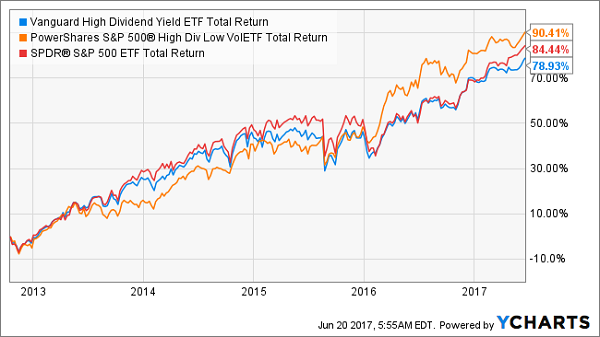
SPDR Gold Shares (GLD)
Assets: $34.3 billion
Category Asset Rank (Gold): 1
Overall Asset Rank: 17
Go check out a few stories about gold today. Then tell me this: Out of any of those stories that mentions an exchange-traded fund as a proxy, how many of them mention the SPDR Gold Shares (GLD)?
It’s natural. The GLD is the oldest and largest gold ETF on the market, and it does a fine job of tracking the price of the yellow metal thanks to its actual physical holdings. And scoff if you will, but there’s a lot to be said about grabbing a ticker that’s as good as GLD.
SOLUTION #3: But don’t sleep on the #2 in the space, because for long-term individual investors like you and me, the iShares Gold Trust (IAU) is simply better. If you insist on owning gold, own it through the IAU. The reason why the GLD has higher assets under management is because its higher liquidity, as well as its higher price and representation of gold (1/10th of an ounce versus IAU’s 1/100th of an ounce) makes it more cost-efficient for institutional investors. But you and I will benefit far more from IAU’s far lower expenses (GLD 0.4%, IAU 0.25%), leading to overall better performance, over time.
GLD Is as Good as Gold, But IAU Is a Little Better
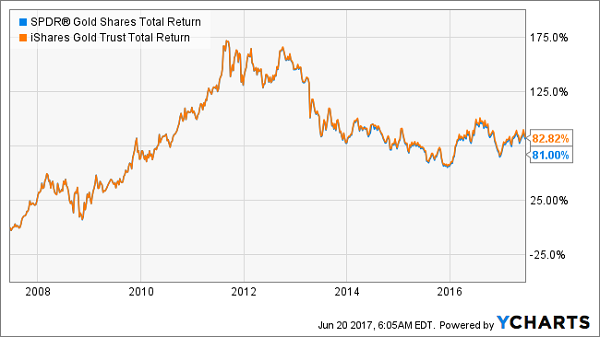
Vanguard REIT ETF (VNQ)
Assets: $62.5 billion
Category Asset Rank (REIT): 1
Overall Asset Rank: 16
Real estate investment trusts (REITs) are an income hunter’s best friend. These tax-advantaged business structures dole out at least 90% of their taxable income to shareholders in the form of dividends, typically resulting in very safe, very attractive yields of 4% to 7%.
So why does the Vanguard REIT ETF (VNQ) – and so many other REIT ETFs, for that matter – yield so little?
If you jump into the VNQ today, you’re sitting on a yield of 4.3%. That’s not awful, obviously, but it’s a little chintzy given the generous yields you can easily find in real estate. That’s because the VNQ, which invests in America’s biggest REITs (and weights them by size), tends to favor larger, established REITs with less robust yields thanks to both price gains, but also slowing dividend growth.
Again, Vanguard doesn’t make many bad funds, and VNQ is no slouch, offering diversified exposure for a song. But …
SOLUTION #4: If you’re going to invest in an income-generating asset, generate some income! The PowerShares KBW Premium Yield Equity REIT Portfolio (KBWY) is a collection of mid- to small-sized REITs that offer up a double whammy of higher yields (due to their relatively higher risk) and growth potential (due to their relatively smaller size). These are REITs such as Global Medical REIT (GMRE) and Washington Prime Group (WPG), which help the KBWY throw off a fat yield of nearly 7%.
Over the past five years, it’s not even close. The KBWY has taken off, providing nearly a doubler in total returns that puts Vanguard’s (and most other) offerings to shame.
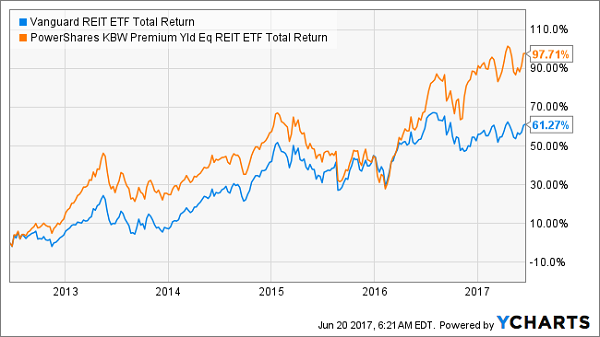
SPDR S&P 500 ETF (SPY)
Assets: $236 billion
Category Asset Rank (Large-cap stock): 1
Overall Asset Rank: 1
How can I badmouth the largest and oldest ETF in existence?
Easy. With stats.
The SPDR S&P 500 ETF (SPY) is the father of exchange-traded funds, providing cheap, simple exposure to the S&P 500 and its bundle of large- and mid-cap stocks, led by the likes of Apple (AAPL), Alphabet (GOOGL) and Exxon Mobil (XOM). When you’re talking about performance, the S&P 500 is “the market,” and it’s hard to beat the market – just ask the majority of hedge fund managers and large-cap mutual fund managers, who are unable to achieve what the S&P 500 does just by waking up in the morning.
And yet.
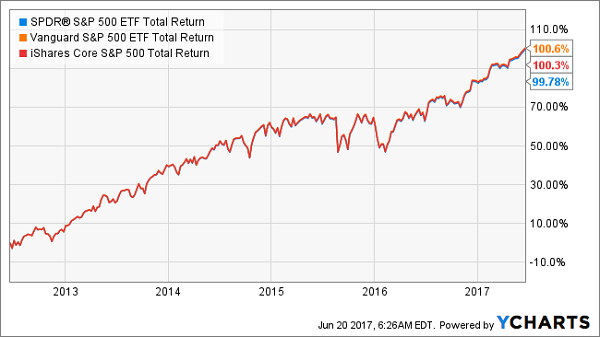
SOLUTIONS #5 & #6: I’ve shown you before how even the tiniest variance in fees, when all else is equal, can make literally thousands of dollars of difference. The SPY is the perfect example of that.
Look at the following chart comparing the projected returns of the SPY versus the iShares Core S&P 500 ETF (IVV) based on the same starting $10,000 investment, and the same expected 7% in annual fund gains.
Expenses Add Up
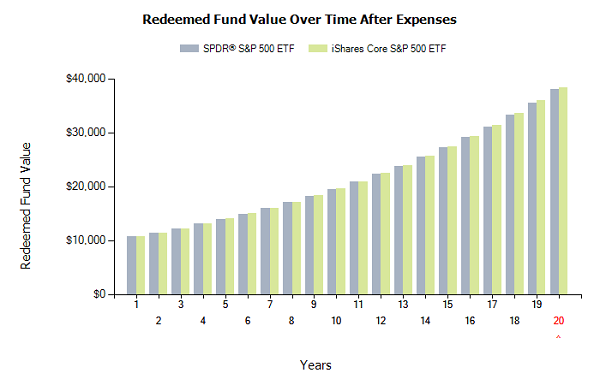
You’ll find a similar expected outcome in the Vanguard S&P 500 ETF (VOO), which like IVV charges just 4 basis points in expenses, versus 9.45 basis points in the SPY.
On top of that, both VOO and the IVV have the ability to use derivatives and other methods to squeeze out a tiny amount of outperformance, versus SPY’s stricter standards. Over the course of a few decades, these tools and slightly lower fees will add up.
Live Off Dividends Forever With This “Ultimate” Retirement Portfolio
SOLUTION #7: Most of the market’s highest-asset ETFs are perfectly fine options, they’re just not great. But you have to ask yourself: Did you work all these years for a retirement that’s simply “fine” … or did you bust your tail to earn something great?
My 8%-yielding “No Withdrawal” portfolio is the path to retirement greatness.
I can’t tell you how many market pundits and financial advisors point retirement investors in the direction of these uber-popular ETFs. They’re not trying to do harm – they’re just making easy, popular picks because they don’t want to rock the boat.
But the only way to actually live out your retirement is to dig deeper and actually find the undiscovered gems in the market that won’t just hold your money for you, but actually grow it – via fat 8%-plus dividends, income growth and the potential for double-digit capital returns!
If you have the whole enchilada, these “ultimate retirement stocks” will ensure that you can live off income alone without ever touching your nest egg!
Think about the “safe” blue-chip stocks and funds that typically top the recommendation lists. They yield 3%, maybe 4% on the high end, but that math doesn’t work! On a nest egg of $500,000, a 4% return nets you just $20,000 in annual income!
Does that sound like a great retirement … or does that sound like barely getting by?
My “No Withdrawal” portfolio guarantees that you won’t have to settle for less during the most important years of your life by providing an 8% yield you can live off while growing your nest egg. While it took several months of digging through a number of high-dividend duds, I’ve weeded out the yield traps and come up with an “ultimate” dividend portfolio that provides you with …
- No-doubt 6%, 7% even 8% yields – and in a couple of cases, double-digit dividends!
- The potential for 7% to 15% in annual capital gains
- Robust dividend growth that will keep up with (and beat) inflation
I love this all-star roster of stocks because of it’s incredible diversification. It has REITs. It has preferred stocks. It has closed-end funds. In other words, it has built-in protection against some of the worst-case scenarios the market can throw your way!
Even then, this safe portfolio still yields 8% as a whole, letting you live off dividend income alone without ever touching your nest egg. That means you can pay all of your monthly bills without ever worrying about wrecking your retirement account if disaster strikes.
Don’t scrape by on meager blue-chip returns and Social Security checks. You’ve worked too hard to settle when it matters most. Instead, invest intelligently and collect big, dependable dividend checks that will let you see the world and live in comfort for the rest of your post-career life.
Let me show you the path to the retirement you deserve. Click here and I’ll provide you with THREE special reports that show you how to build this “No Withdrawal” portfolio. You’ll get the names, tickers, buy prices and full analysis of their wealth-building potential – and it’s absolutely FREE!
